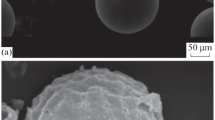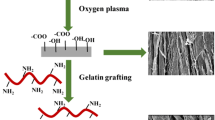Abstract
Microporous membranes with controlled pore size and structure were produced from biodegradable polyurethane based on aliphatic diisocyanate, poly(ε-caprolactone) diol and isosorbide chain extender using the modified phase-inversion technique. The following parameters affecting the process of membrane formation were investigated: the type of solvent, solvent–nonsolvent ratio, polymer concentration in solution, polymer solidification time, and the thickness of the polymer solution layer cast on a substrate. The experimental systems evaluated were polymer–N,N-dimethylformamide–water, polymer–N,N-dimethylacetamide–water and polymer–dimethylsulfoxide–water. From all three systems evaluated the best results were obtained for the system polymer–N,N-dimethylformamide–water. The optimal conditions for the preparation of microporous polyurethane membranes were: polymer concentration in solution 5% (w/v), the amount of nonsolvent 10% (v/v), the cast temperature 23°C, and polymer solidification time in the range of 24–48 h depending on the thickness of the cast polymer solution layer. Membranes obtained under these conditions had interconnected pores, well defined pore size and structure, good water permeability and satisfactory mechanical properties to allow for suturing. Potential applications of these membranes are skin wound cover and, in combination with autogenous chondrocytes, as an “artificial periosteum” in the treatment of articular cartilage defects.








Similar content being viewed by others
References
Gogolewski S, Pennings AJ, Lommen E, Wildevuur CRH, Nieuwenhuis P. Growth of a neo-artery induced by a biodegradable polymeric vascular prosthesis. Makromol Chem Rapid Commun. 1983;4(4):213–9.
Gogolewski S, Pennings AJ. An artificial skin based on biodegradable mixtures of polylactides and polyurethanes for full thickness wound covering. Makromol Chem Rapid Commun. 1983;4(10):675–80.
Lipatova TE, Pkhakadze GA, Snegirev AI, Vorona VV, Shilov VV. Supermolecular organization of some polyurethanes containing sugar derivatives in the main chain. J Biomed Mater Res. 1984;18(2):129–36.
Gogolewski S, Galletti G. Degradable, microporous vascular prosthesis from segmented polyurethane. Colloid Polym Sci. 1986;264(10):854–8.
Gogolewski S, Galletti G, Ussia G. Polyurethane vascular prosthesis in pigs. Colloid Polym Sci. 1987;265(9):774–8.
Gogolewski S, Walpoth B, Rheiner P. Polyurethane microporous membranes as pericardial substitutes. Colloid Polymer Sci. 1987;265(11):971–7.
Gogolewski S. Selected topics in biomedical polyurethanes: a review. Colloid Polym Sci. 1998;267(9):757–85.
Walpoth BH, Rheiner P, Cox JN, Faidutti B, Megevand R, Gogolewski S. Implantations chroniques de membranes et prothèses en polyurethanes. Helv Chir Acta. 1988;55(1–2):157–62.
Farsø Nielsen F, Karring T, Gogolewski S. Healing of radial bone defects in rabbits using biodegradable membranes. J Dent Res. 1990;69:168–9.
Kostopoulos L, Karring T. Guided bone regeneration in mandibular defects in rats using a bioresorbable polymer. Clin Oral Implants Res. 1994;5(2):66–74.
Warrer K, Karring T, Nyman S, Gogolewski S. Guided tissue regeneration using biodegradable membranes of polylactic acid or polyurethane. J Clin Periodontol. 1992;19:633–40.
Farsø Nielsen F, Karring T, Gogolewski S. Biodegradable guide for bone regeneration Polyurethane membranes tested in rabbit radius defects. Acta Orthop Scand. 1992;63(1):66–9.
Atala A, Lanza RP, editors. Methods of tissue engineering. San Diego: Academic Press; 2001.
Gorna K, Gogolewski S. In vitro degradation of novel medical biodegradable aliphatic polyurethanes based on ε-caprolactone and Pluronics® with various hydrophilicities. Polym Degrad Stabil. 2002;75(1):113–22.
Gorna K, Gogolewski S. Porous biodegradable polyurethane scaffolds for tissue repair and regeneration. J Biomed Mater Res. 2006;79A(1):128–38.
Lee CR, Grad S, Gorna K, Gogolewski S, Goessl A, Alini M. Fibrin–polyurethane composites for articular cartilage tissue ngineering: A preliminary analysis. Tissue Eng. 2005;11(9–10):1562–73.
Chia SL, Gorna K, Gogolewski S, Alini M. Potential of elastomeric membranes from biodegradable polyurethanes as periosteal flap substitute: A preliminary in vitro evaluation. Tissue Eng. 2006;12(7):1945–53.
Chroscicka A, Tsui YK, Alini M, Gogolewski S. Differentiation of human mesenchymal stem cells on biodegradable polyurethane membranes for tissue engineering. In: Transactions of the 2006 annual meeting of the society for biomaterials, Pittsburgh, USA, p. 571, 2006, April 26–29.
Hill CM, An YH, Kang QK, Hartsock LA, Gogolewski S, Gorna K. Osteogenesis of osteoblast seeded polyurethane-hydroxyapatite scaffolds in nude mice. Macromol Symp. 2007;253:94–7.
Schlickewei C, Verrier S, Lippross S, Pearce S, Alini M, Gogolewski S. Interaction of sheep bone marrow stromal cells with biodegradable polyurethane bone substitutes. Macromol Symp. 2007;253:162–71.
Gogolewski S. Biomedical polymer material for tissue repair and engineering. WO2008017170-A1; 2008.
Walinska K, Iwan A, Gorna K, Gogolewski S. The use of long-chain plant polyprenols as a means to modify biological properties of new biodegradable polyurethane scaffolds for tissue engineering. A pilot study. J Mater Sci: Mater Med. 2008;19:129–35.
Gogolewski S, Gorna K, Turner AS. Regeneration of bicortical defects in the iliac crest of estrogen-deficient sheep, using new biodegradable polyurethane bone graft substitutes. J Biomed Mater Res. 2006;77A(4):802–10.
Gogolewski S, Gorna K. Biodegradable polyurethane cancellous bone graft substitutes in the treatment of iliac crest defects. J Biomed Mater Res. 2007;80A(1):94–101.
Guan JJ, Fujimoto KL, Sacks MS, Wagner WR. Preparation and characterization of highly porous, biodegradable polyurethane scaffolds for soft tissue applications. Biomaterials. 2005;26(18):3961–71.
dal Prà P, Petrini A, Charini S, Bozzini S, Farè S, Armato U. Silk fibroin-coated three-dimensional polyurethane scaffolds for tissue engineering: interactions with normal human fibroblasts. Tissue Eng. 2003;9(6):1113–21.
Siepe M, Giraud MN, Liljensten E, Nydegger U, Menasche P, Carrel T, et al. Construction of skeletal myoblast-based polyurethane scaffolds for myocardial repair. Artif Organs. 2007;31(6):425–33.
Hafeman AE, Li B, Yoshii T, Zienkiewicz K, Davidson JM, Guelcher SA. Injectable biodegradable polyurethane scaffolds with release of platelet-derived growth factor for tissue repair and regeneration. Pharmaceutical Res. 2008;25(10):2387–99.
Ramarattan NN, Heikants RGJC, van Tienen TG, Schouten AJ, Veth RPH, Buma P. Assessment of tissue ingrowth rates in polyurethane scaffolds for tissue engineering. Tissue Eng. 2005;11(7–8):1212–23.
Zhu YB, Gao CY, Guan JJ, Shen JC. Engineering porous polyurethane scaffolds by photografting polymerization of methacrylic acid for improved endothelial cell compatibility. J Biomed Mater Res. 2003;67A(4):1367–73.
Zhang JY, Doll BA, Beckman EJ, Hollinger JO. A biodegradable polyurethane-ascorbic acid scaffold for bone tissue engineering. J Biomed Mater Res. 2003;67A(2):389–400.
Guelcher SA, Patel V, Gallagher KM, Connolly S, Didier JE, Doctor JS, et al. Synthesis and in vitro biocompatibility of injectable polyurethane foam scaffolds. Tissue Eng. 2006;12(5):1247–59.
Borkenhagen M, Stoll RC, Neuenschwander P, Suter UE P, Aebischer P. In vivo performance of a new biodegradable polyester urethane system used as a nerve guidance channel. Biomaterials. 1998;19(23):2155–65.
Van Tienen TG, Heikants RGJC, Buma AP, De Groot JH, Pennings AJ, Veth RPH. Tissue ingrowth and degradation of two biodegradable porous polymers with different porosities and pore sizes. Biomaterials. 2002;23(8):1731–8.
McDevitt TC, Woodhouse KA, Hauschka SD, Murry CE, Stayton PS. Spatially organized layers of cardiomyocytes on biodegradable polyurethane films for myocardial repair. J Biomed Mater Res. 2003;66A(3):586–95.
Zhu YB, Gao CY, He T, Shen JC. Endothelium regeneration on luminal surface of polyurethane vascular scaffold modified with diamine and covalently grafted with gelatin. Biomaterials. 2004;25(3):423–30.
Brittberg M, Lindahl A, Nilsson A, Ohlsson C, Isaksson O, Peterson L. Treatment of deep cartilage defects in the knee with autologous chondrocyte transplantation. N Engl J Med. 1994;331(14):889–95.
Peterson L, Minas T, Brittberg M, Lindahl A. Treatment of osteochondritis dissecans of the knee with autologous chondrocyte transplantation. J Bone Joint Surg Am. 2003;85-A Suppl 2:17–24.
Klempner D, Frisch KC. The handbook of polymeric foams and foam technology. Munich, Germany: Hauser; 1991.
Mulder MHV. Basic principles of membrane technology. Dordrecht, Holland: Kluwer; 1991.
Kesting RE, Fritzsche AK. Polymeric gas separation membranes. New York: Wiley; 1993.
Strathmann H. Production of microporous media by phase inversion processes. In: Lloyd DR, editor. Materials science of synthetic membranes. Washington, DC: American Chemical Society; 1985. p. 165–95.
Strathmann H. Synthetic membranes and their preparation. In: Porter MC, editor. Handbook of industrial membrane technology. Park Ridge, NJ: Noyes; 1990. p. 1–26.
Laxminarayan A, Caneba GT. Analysis of polymer membrane formation through spinodal decomposition. II: Effect of Flory-Huggins enthalpic and entropic contributions. Polym Eng Sci. 1957;31(22):1597–603.
Van de Witte P, Dijkstra PJ, Van den Berg JWA, Feijen J. Phase separation processes in polymer solutions in relation to membrane formation. J Membr Sci. 1996;117(1–2):1–31.
Koenhen DM, Mulder MHV, Smolders CA. Phase separation phenomena during the formation of asymmetric membranes. J Appl Polym Sci. 1997;21(1):199–215.
Mikos AG, Temenoff JS. Formation of highly porous biodegradable scaffolds for tissue engineering. Electronic J Biotechnol. 2000;3(2):114–9.
Wright Medical Technology Brochure: SK 103–303; Rev. 09.04: 2004.
Farsø-Nielsen F, Karring T, Gogolewski S. Healing of radial bone defects in rabbits using biodegradable polyurethane membranes. In: Proceedings of the IADR/AADR conference, Cincinnati, USA, p. 16, 1990, Sept 3–5.
Gogolewski S, Rahn B, Wieling R. Bone regeneration in critical-size segmental defects in the tibiae using bioresorbable polymeric bone substitute. Proceedings of the 17th annual meeting of the Orthopaedic Trauma Association, San Diego, USA, p. 218–219, 2001, Oct 18–20.
Acknowledgement
One of the authors (Yuen Kee Tsui) thanks Ms. Katarzyna Gorna, PhD, for her help with polyurethane synthesis and DSC measurements.
Author information
Authors and Affiliations
Corresponding author
Rights and permissions
About this article
Cite this article
Tsui, Y.K., Gogolewski, S. Microporous biodegradable polyurethane membranes for tissue engineering. J Mater Sci: Mater Med 20, 1729–1741 (2009). https://doi.org/10.1007/s10856-009-3722-4
Received:
Accepted:
Published:
Issue Date:
DOI: https://doi.org/10.1007/s10856-009-3722-4




